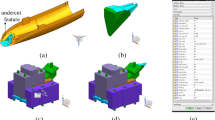Abstract
The success in developing a metal forming process is relied heavily on the design of a preform to reduce the final forming load at the final step. The design of the preform is considered a big burden of a process designer. Currently, the automotive companies try to design components which can cover a wide range of car models, but only changing a few dimensions to accommodate different models. However, each product is still considered a single product during the process design. Therefore, if only one preform can cover a variety of products, the process design could speed-up and gain more benefits in the production. In this research, a technique to design preform for various product models was proposed. The aim of this technique is to develop generalized common preforms by utilizing the same part configuration/shape but different dimensions in some areas to reduce the number of preform and process design time. This technique is composed of two steps: (a) classification of product groups and (b) determination of the common tool for producing the common parts. This technique was applied to the cold forging process to produce various models of automotive pulleys. The results show that the number of preforms was reduced by almost 70%, and the die changeover time was approximately saved by 75 min per shift (8 h/shift), and the capacity was gained by 1800 pieces per shift without generating any product defects.
































Similar content being viewed by others
References
Park JJ, Rebelo N, Kobayashi S (1983) A new approach to preform design in metal forming with the finite element method. Int J Mach Tool Des Res 23(1):71–79. https://doi.org/10.1016/0020-7357(83)90008-2
Kim N, Kobayashi S (1990) Preform design in H-shaped cross sectional axisymmetric forging by the finite element method. Int J Mach Tools Manuf 30(2):243–268. https://doi.org/10.1016/0890-6955(90)90134-5
Kang BS, Kim N, Kobayashi S (1990) Computer-aided preform design in forging of an airfoil section blade. Int J Mach Tools Manuf 30(1):43–52. https://doi.org/10.1016/0890-6955(90)90040-P
Thiyagarajan N, Grandhi RV (2005) Multi-level design process for 3-D preform shape optimization in metal forming. J Mater Process Technol 170(1–2):421–429. https://doi.org/10.1016/j.jmatprotec.2005.05.051
Di Lorenzo R, Micari F (1998) An inverse approach for the design of the optimal preform shape in cold forging. CIRP Ann 47(1):189–192. https://doi.org/10.1016/S0007-8506(07)62815-7
Sheu JJ, Yu CH (2009) Preform and forging process designs based on geometrical features using 2D and 3D FEM simulations. Int J Adv Manuf Technol 44(3–4):244–254. https://doi.org/10.1007/s00170-008-1834-5
Yang C, Ngaile G (2010) Preform design for forging and extrusion processes based on geometrical resemblance. Proc Inst Mech Eng B J Eng Manuf 224(9):1409–1423. https://doi.org/10.1243/09544054JEM1799
Altan T, Ngaile G, Shen G (2004) Cold and hot forging: fundamentals and applications, vol 1. ASM international, pp 67–81
Author information
Authors and Affiliations
Corresponding author
Additional information
Publisher’s note
Springer Nature remains neutral with regard to jurisdictional claims in published maps and institutional affiliations.
Rights and permissions
About this article
Cite this article
Nakeenopakun, N., Aue-u-lan, Y. A proposed Common Single-Die Exchange Technique (C-SDET) to enhance production of pulleys. Int J Adv Manuf Technol 107, 3625–3643 (2020). https://doi.org/10.1007/s00170-020-05267-0
Received:
Accepted:
Published:
Issue Date:
DOI: https://doi.org/10.1007/s00170-020-05267-0




